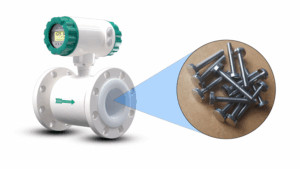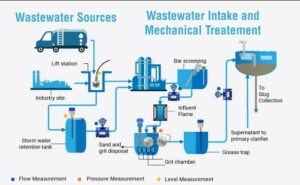Insertion magnetic flow meters are increasingly becoming the go-to choice for industries seeking a cost-effective, low-maintenance, and efficient solution for flow measurement. From water treatment plants to chemical manufacturing, these meters offer distinct advantages in terms of ease of installation, retrofit capability, and affordability—especially for large-diameter pipes.
But here’s the catch: choosing the wrong insertion magnetic flow meter can lead to erratic readings, frequent breakdowns, and massive operational costs. Most procurement errors stem from avoidable mistakes—oversights that can be costly in the long run.
In this comprehensive guide, we’ll walk you through the top 5 critical mistakes buyers make when purchasing insertion magnetic flow meters—and show you how to avoid them like a seasoned pro.
Mistake #1: Ignoring Fluid Conductivity Requirements
Electromagnetic flow meters only work with conductive fluids. One of the most fundamental requirements for a magnetic flow meter to function is that the fluid must have a minimum electrical conductivity, typically above 5 μS/cm.
What happens if you ignore this?
-
The meter won’t produce accurate readings—or any readings at all.
-
You risk false alarms, signal loss, and unnecessary service calls.
How to avoid it:
-
Verify the conductivity of your process fluid before selecting the meter.
-
If you’re dealing with low-conductivity liquids like deionized water, alcohol, or hydrocarbons, consider an ultrasonic flow meter instead.
Pro Tip: Some manufacturers offer models optimized for lower conductivity fluids, but even these have limits. Always check technical specifications.
Mistake #2: Choosing the Wrong Electrode or Liner Material
Many buyers underestimate the importance of material compatibility between the flow meter and the process fluid. The electrodes and liner of the insertion probe come into direct contact with the liquid. Using incompatible materials can lead to:
-
Corrosion
-
Erosion
-
Premature sensor failure
Example:
-
Using stainless steel electrodes in chloride-rich environments (like seawater or bleach processes) will lead to rapid degradation.
How to avoid it:
-
Match the electrode material (e.g., stainless steel, Hastelloy C, titanium, tantalum) with the chemical properties of your fluid.
-
Select a liner material (e.g., PTFE, PFA, rubber) that can withstand your operating temperature and pressure.
Pro Tip: Always consult a chemical compatibility chart when in doubt.
Mistake #3: Overlooking Installation Requirements
Insertion magnetic flow meters may be easier to install than full-bore meters, but they still require careful installation to function correctly.
Common installation pitfalls:
-
Installing too close to bends, valves, or pumps
-
Not maintaining adequate straight pipe runs
-
Failing to ensure grounding and proper probe positioning
How to avoid it:
-
Follow the manufacturer’s guidelines for minimum upstream and downstream straight pipe lengths (typically 10D upstream and 5D downstream).
-
Ensure the electrode is aligned properly with the flow direction.
-
Use grounding rings or electrodes if the pipe is non-conductive (e.g., PVC).
Pro Tip: Always perform a site survey before selecting your meter to verify suitable tapping locations.
Mistake #4: Not Considering Flow Profile and Pipe Size
Unlike full-bore models that measure flow across the entire cross-section, insertion meters sample velocity at a single point (or multiple points in some advanced designs). If your flow is non-uniform, the readings could be significantly off.
What causes flow profile issues?
-
Distorted flow from nearby bends or valves
-
Partially filled pipes
-
Poor velocity distribution in oversized pipes
How to avoid it:
-
For large pipes (above DN300 or 12”), consider multi-point insertion flow meters that average readings across several depths.
-
Always mount the sensor in a location with a stable, fully developed flow profile.
-
Make sure the pipe is completely filled during operation.
Pro Tip: Some manufacturers provide insertion depth guidelines based on pipe diameter and fluid velocity.
Mistake #5: Buying Based on Price Alone
In the world of industrial instrumentation, cheap often means expensive in the long run. Buying a low-cost insertion magnetic flow meter from a no-name brand can lead to:
-
Poor accuracy and reliability
-
Lack of after-sales support
-
Frequent recalibration or sensor failure
-
No certifications for industry compliance
How to avoid it:
-
Choose reputable manufacturers with a proven track record.
-
Look for certifications like ISO, CE, ATEX, or NSF, depending on your industry.
-
Compare warranties, support options, and service availability, not just sticker price.
Pro Tip: Always factor in total cost of ownership (TCO)—including installation, maintenance, and downtime—not just purchase price.
Bonus Mistake: Skipping Flow Meter Calibration and Verification
Even the best insertion magnetic flow meter needs periodic calibration or verification to maintain its specified accuracy. Skipping this step can result in:
-
Incorrect billing
-
Process deviations
-
Regulatory non-compliance
How to avoid it:
-
Choose meters with built-in verification tools or external diagnostic software.
-
Establish a routine calibration schedule based on usage conditions and criticality.
-
For custody-transfer or compliance applications, consider third-party certification.
How to Select the Right Insertion Magnetic Flow Meter: A Checklist
Here’s a quick checklist to ensure you’re making a smart, mistake-free purchase:
✅ Is the fluid conductive?
✅ Have you selected compatible electrode and liner materials?
✅ Does the installation location meet straight-pipe requirements?
✅ Is the pipe always full, and is the flow profile stable?
✅ Are you choosing a reputable supplier with solid support?
✅ Will you have a plan for calibration and verification?
If you answered “yes” to all the above, you’re on the right path.
Real-World Example: A Mistake That Cost $100,000
A beverage manufacturing plant installed a dozen low-cost insertion mag meters sourced from an unknown overseas vendor. Within months:
-
Several meters failed due to corrosion from acidic juices.
-
Readings became erratic due to grounding issues.
-
Process lines had to be shut down for recalibration and replacement.
Total cost in lost production and repairs? Over $100,000—all because of cutting corners during purchase.
They switched to reputable meters with tantalum electrodes, PTFE liners, and a built-in grounding system. No issues since.
Lesson: Saving on purchase price can cost big in operational disruption.
Conclusion: Smart Purchases Start with Smart Questions
Insertion magnetic flow meters are fantastic tools—when chosen and installed correctly. They’re not “one-size-fits-all,” and making the wrong choice can lead to more headaches than benefits.
Avoid the five common mistakes:
-
Ignoring fluid conductivity
-
Choosing the wrong materials
-
Poor installation planning
-
Neglecting flow profile considerations
-
Buying based on price alone
We are a manufacturer of automatic flow meters with many years of experience in the industry. We have strong independent research and development capabilities and are a leader in the flow meter industry. Our main products include electromagnetic flow meters, vortex flow meters, turbine flow meters, ultrasonic flow meters, Coriolis flow meters, various solenoid valves, level meters, control units and valves, etc. Welcome to purchase –Best Instrument





